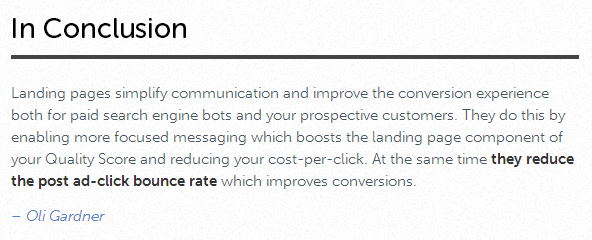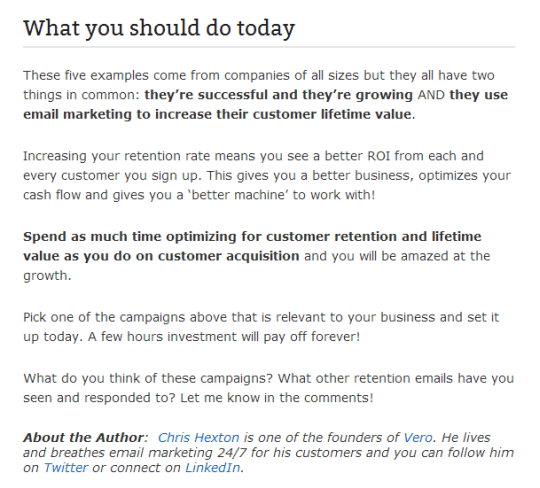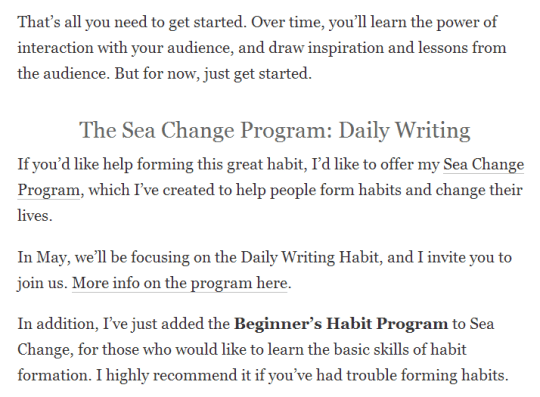One of the biggest challenges in content marketing is how to end a blog post. It can be hard drawing things to a close and end gracefully. Which means the end of a blog post is more of an afterthought than a destination.
Typically, you see one of three tendencies:
- Forgetting the close altogether
- Awkwardly restating the main point
- Turning the article into a sales page and making an overt sales pitch
Uhm. No.
Today, I want to talk about the art of the close in a business blog. In particular, we’ll talk about five ways to close your article so the reader is satisfied and knows what to do next.
Blog Post Ending #1: Full circle
What’s the easiest way to end a blog post? Remind readers of your original promise.
Over the years, I’ve discovered that if you can’t state the purpose of an article in one sentence, you don’t really know what you want to say. But if you can, writing is easy—including writing a powerful close.
All you have to do is circle back to where you started, explaining how everything you’ve talked about supports your original statement. Then add a final thought or challenge.
While this sounds easy enough, in practice, it’s hard to do. You don’t want to copy and paste your thesis. And you don’t want to tack on an unrelated idea that doesn’t add value.
You want to treat your close as a destination. In my opinion, a benefit statement is the best way to do this. And it can be as simple as Oli Gardner’s conclusion here.
In this case, it’s just a phrase that reminds people of the value of the information they’ve read: “which improves conversions.”
It tells readers of why they need this information, so they’re more likely to remember and enagage with it.
Blog Post Ending # 2: The direct approach
Don’t beat around the bush. Ask for a response.
Because content marketing is an indirect form of marketing, with the goals of engagement, relationship-building and generating interest in your product/brand, comments and social shares are a good measure of how well you’re doing.
But you don’t have to leave it to chance. You can ask for engagement. See how Sonia Simone does it in this Copyblogger article.
See how easy it is? Just ask questions and invite people to answer them in a comment.
Blog Post Ending #3: The task list
This one works well for how-to articles, and it’s simple. Tell your readers what to do now.
There are different types of content: idea-based and application-based.
The first shares information or ideas. The second goes one step further. Instead of just sharing ideas, it tells people how they can apply those ideas to their own projects or problems.
Even if you aren’t writing a how-to article, telling people what to do next or how to do it themselves can make a strong close for your content.
Like this close by Chris Hexton on Crazy Egg.
After sharing useful, detailed information, he wraps it up with a compelling close:
- He tells readers why he chose the examples they just read about.
- He gives a specific benefit of learning to do what they do.
- He shares a simple concept that adds to readers’ understanding.
- He assigns a task that will help them get started.
He could have stopped there, but he goes even further to engage readers by asking questions that encourage comments. This is a great way to give readers a satisfying experience on your blog.
Blog Post Ending #4: An invitation
If you’ve got an engaged audience, why not ask for your reader’s response to what they just read?
You don’t always have to have the definitive answer to the question. You can be the thought leader, the question-asker, the researcher, or the compiler of information.
This is a twist on the popular “ask for comments” strategy, and it’s as easy as asking readers to add to your content or share their expertise in the comments. People love to feel smart, and this is a great way to give them that platform.
Here are two posts that do this well.
This one, from Unbounce, directly asks for input from readers:
And this one comes from ProBlogger’s Darren Rowse. It’s a little less direct, simply stating that he’s “keen to learn.”
Blog Post Ending #5: The close + an offer
A great way to end a business blog post is to tie the information you’ve just shared to one of your products
Content is not for selling. But it is part of the customer journey. Every blog post you publish should relate in some way to your product. It should:
- Answer questions that people frequently ask
- Address the issues around problems you solve
- Rank for the keywords your customers search for when they’re trying to solve a problem your product solves
To engage cold traffic, your articles should provide value all by themselves. Then, to draw that traffic into your universe, include a banner below it or make a low-key offer in the close of your post.
I like how Leo Babauta does it in this article from Zen Habits.
For all practical purposes, the post ends above the last subhead. If you want to stop reading there, you can.
But if you’re the least bit interested in learning more, Leo gives a low-pressure pitch that links to a sales page.
How do you know which close to use?
It’s up to you. The close of an article should do two things:
- Wrap up your ideas in a satisfying way.
- Create a sense of closure.
Hopefully, it will also:
- Invite engagement, such as commenting or social sharing.
- Build relationship.
- Tell people what to do next.
How you do that is up to you. But a good place to start is with one of the five closes you just read about. Any of them can help you craft an ending that’s a destination and not just an afterthought.
Now what about you? How do you end a blog post?








